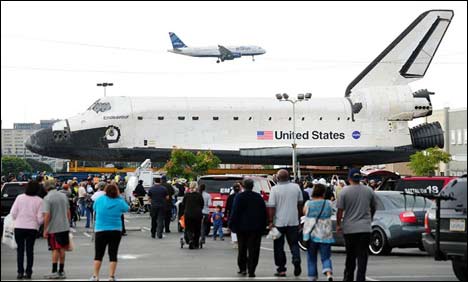October 14, 2012
LOS ANGELES: The US space shuttle Endeavour began its final journey Friday, at the less-than rocket-propelled speed of 2 mph (3.2 kmh), in a meticulously planned trip through the streets of Los Angeles.

October 14, 2012
LOS ANGELES: The US space shuttle Endeavour began its final journey Friday, at the less-than rocket-propelled speed of 2 mph (3.2 kmh), in a meticulously planned trip through the streets of Los Angeles.

Some 400 trees have had to be cut down – provoking initial protests from locals – and power lines turned off to make way for the 78-ton vehicle on the two-day, 12-mile (19 km) journey to the California Science Center.
The enormous white spacecraft, which stopped on a parking lot after being brought out of a hangar overnight, began moving early afternoon, looking like a giant ocean liner cruising surreally across LA's mostly low-level cityscape.
"It's pretty neat to see a spaceship in the street," one spectator told local KCAL 9 television, which broadcast live footage of the slow-moving shuttle procession along boulevards lined with onlookers.
The shuttle, which flew more than 115 million miles (185 million kilometers) in its two-decade career, landed at LA international (LAX) airport three weeks ago piggy-backed on a specially-fitted 747.
Since then it has been in an airport hangar. But it was rolled out overnight for its final journey, which risks causing traffic chaos before it reaches its destination late Saturday.
The shuttle is mounted on a high-tech flatbed carrier for the trip, which at certain points will involve squeezing around corners within inches of buildings.
"We're off to a great start," said Science Center head Jeffrey Rudolph. "Everything is really going according to plan, exactly as we hoped for. We've still got a long ways to go, but this is an incredibly complex move," he added.
Once underway, organizers walked ahead of the slow-moving behemoth – which weighs about the same as 30 elephants – with bullhorns to sound the alarm if any part of the spacecraft was in danger of hitting anything.
The computer-driven carrier it is mounted on consists of four separate wheeled units, which can turn independently to maneuver their load around difficult corners.
They also mean it can straddle the center divider of LA's wide city streets – some of which had trees on them that had to be cut down in advance. Locals initially protested, but were placated when authorities pledged to plant several times as many new trees to replace them.
Former shuttle commander Mark Kelly, who captained Endeavour's final flight, said he hoped it would become an inspiration for future generations of astronauts.
"Maybe someday one of these kids that see Endeavour, look up at it at the California Science Center, will be that person that walks on the planet Mars," he told CNN, adding: "That would be a great thing to see."
After the space agency NASA brought an end to the 30-year shuttle program last year, major US cities battled for the right to house one of the craft.
Enterprise, the prototype that never flew into space, is now on permanent display on the runway of the Intrepid aircraft carrier in New York.
The Kennedy Space Center will keep Atlantis, and Discovery is on display at a museum outside Washington.
Two other shuttles were destroyed in flight. Challenger disintegrated shortly after liftoff in 1986 and Columbia broke apart upon re-entry to Earth in 2003. Both disasters killed everyone on board.
Courtesy: AFP
















































































































